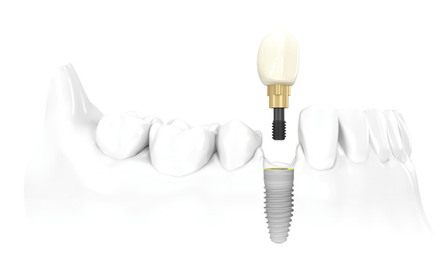
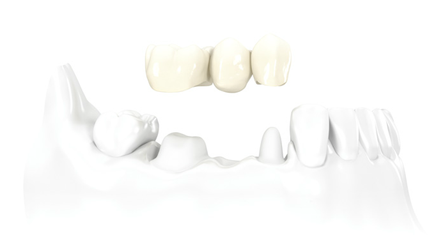
Replacing A Single Tooth
Replacing a single tooth can be achieved with a conventional bridge or an implant retained crown.
The conventional fixed partial denture (fixed bridge) requires that your dentist drills down two or more adjacent teeth to create space for the crowns of the prosthetic teeth. Placing a bridge on natural teeth increases the functional forces that are placed upon them and makes the use of floss between the teeth more difficult. Conventional bridges may need to be replaced if the supporting teeth develop cavities or periodontal disease.
An implant single-tooth restoration avoids the need to restore the adjacent teeth and also replaces the support that is lost with the missing tooth. This allows normal flossing as if the replacement implant were a natural tooth. An implant is placed in the position of the missing tooth. When the implant is stable and ready for loading, an abutment can be attached to the implant that will connect the final crown to the implant.
An impression is made to record the contours of the abutment or the position of the implant top. The crown is then fabricated and fixed in place using cement or screws. An implant crown is not susceptible to cavities but may develop complications if oral hygiene is not maintained. The implant restoration should be routinely evaluated in time intervals that are determined by the conditions of the remaining natural teeth and the implant.
Replacing Multiple Teeth With Dental Implants
Replacing multiple teeth can be achieved with a multiple single-tooth implant restoration, with implant fixed partial dentures (implant bridges), with a removable partial denture (RPD), or with a conventional fixed partial denture (bridge).
The missing teeth may be replaced with multiple single-tooth implant restorations (described under replacing single teeth), or with implant fixed partial dentures (implant bridges). Implant bridges replace the support lost as a result of missing teeth, avoid the need to drill the adjacent teeth and do not require an implant for every missing tooth. Implants are placed in strategic positions to replace the missing teeth. When the implants are stable and ready for loading, abutments can be attached to the implants that will connect the final bridge (prosthesis) to the implants. The implant bridge is retained in place using cement or screws.
Replacement with a conventional fixed partial denture (FPD) or bridge requires reduction of two or more adjacent teeth to make crowns that will be connected to each other with a false (prosthetic) tooth suspended between them. A fixed bridge increases the functional forces placed upon the supporting teeth and complicates the use of floss between the teeth. Conventional bridges may need to be replaced if the supporting teeth develop cavities or periodontal disease.
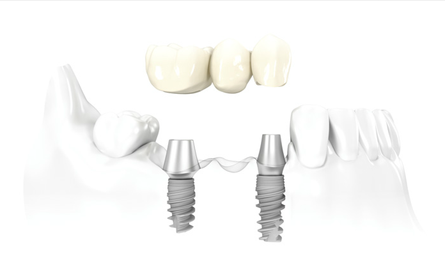
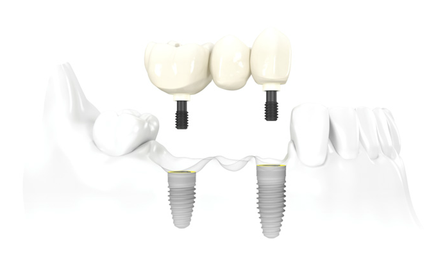
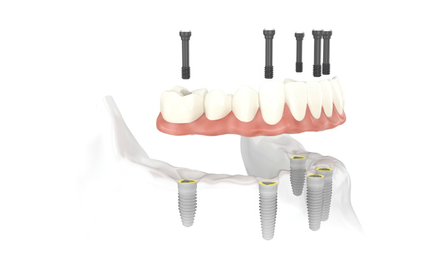
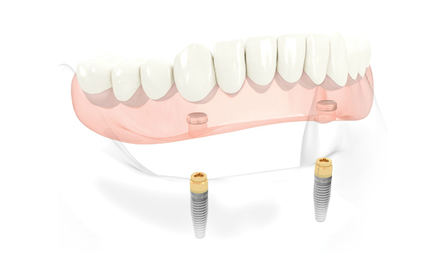
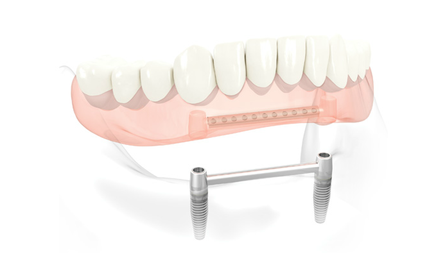
Replacing All Missing Teeth
If you are missing, or need to remove all teeth in one or both jaws, implants may allow you to have a fixed full-arch bridge fabricated as well. As an alternative to wearing a full denture (if there is adequate bone or bone augmentation procedures can be performed to grow sufficient bone) multiple implants can be placed across the jawbone to provide support for a fixed bridge. This procedure is similar to those described for single or multiple implants but requires careful diagnosis, planning and coordination before treatment begins. This attention to detail will ensure that an appropriate number of implants can safely be placed in positions that will allow your dentist to fabricate a bridge which will meet your needs and expectations.
The number of implants necessary for a full-arch fixed bridge varies depending on your particular anatomy, the opposing teeth, the type of bridge you want to have placed and the number of teeth you want or need to replace with the prosthesis. A full arch of implants can be placed when you are already missing all teeth in one of your jaws. If you have teeth remaining, they may need to be removed as a first step before implant surgery can proceed, or sometimes the teeth may be extracted and implants placed immediately after the teeth have been removed. If there are teeth remaining, you may be able to have a temporary fixed-bridge made by your dentist to help transition from your own teeth to implants. In this scenario (while the implants are healing), the temporary bridge stays in place which allows chewing, speaking and smiling – all without having to wear a removable denture. If it is not possible to retain enough teeth to support a fixed bridge while the implants are healing, then you may need to wear a removable denture temporarily.
Alternatively, you could also have an implant assisted dentures fabricated. These dentures are retained by clip on bars or ball and socket type attachments that are attached to implants placed in your jaw. The number of implants needed varies depending on the kind of attachment sought. In any case, implant assisted dentures are far more stable when compared to conventional dentures.